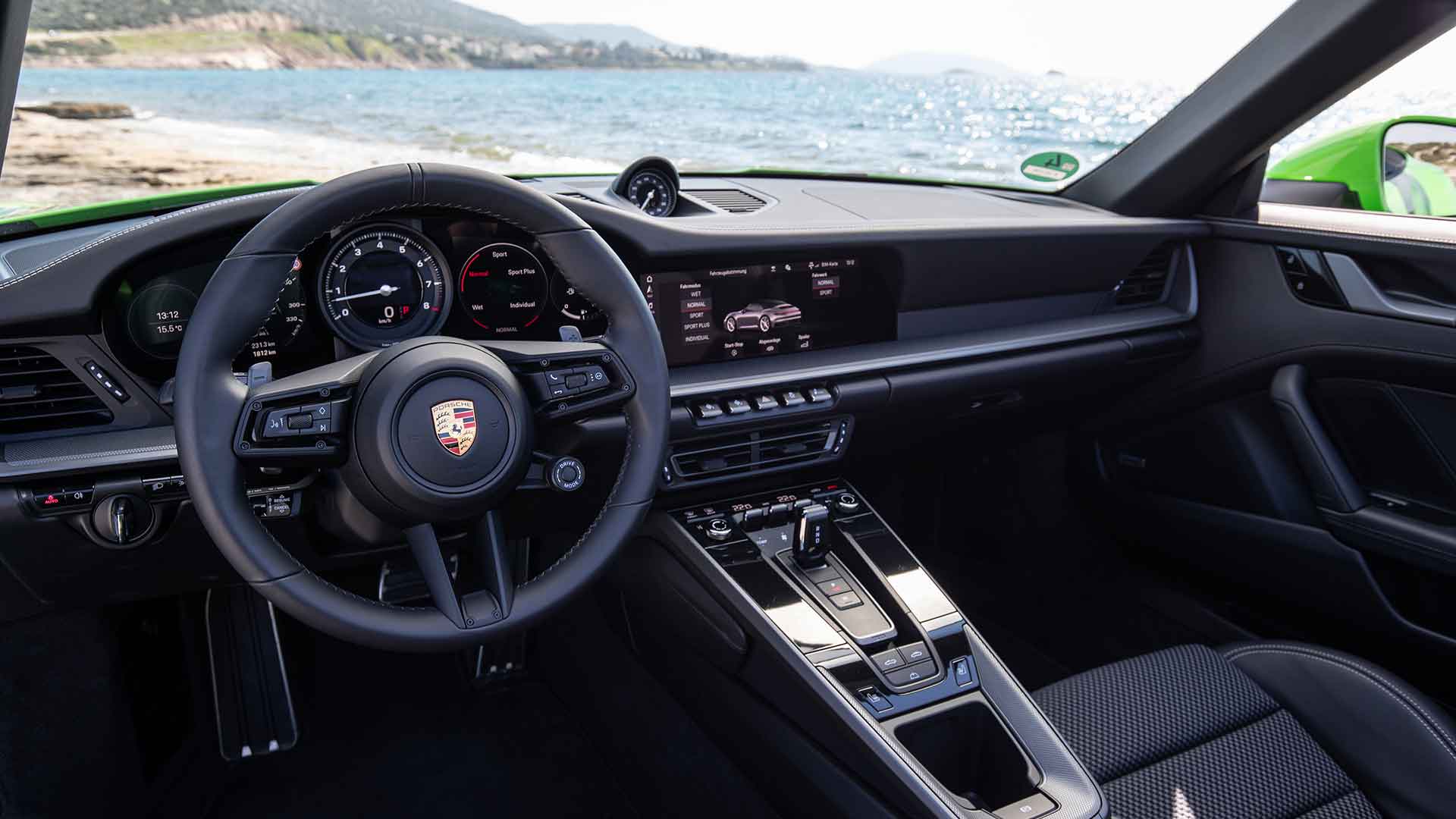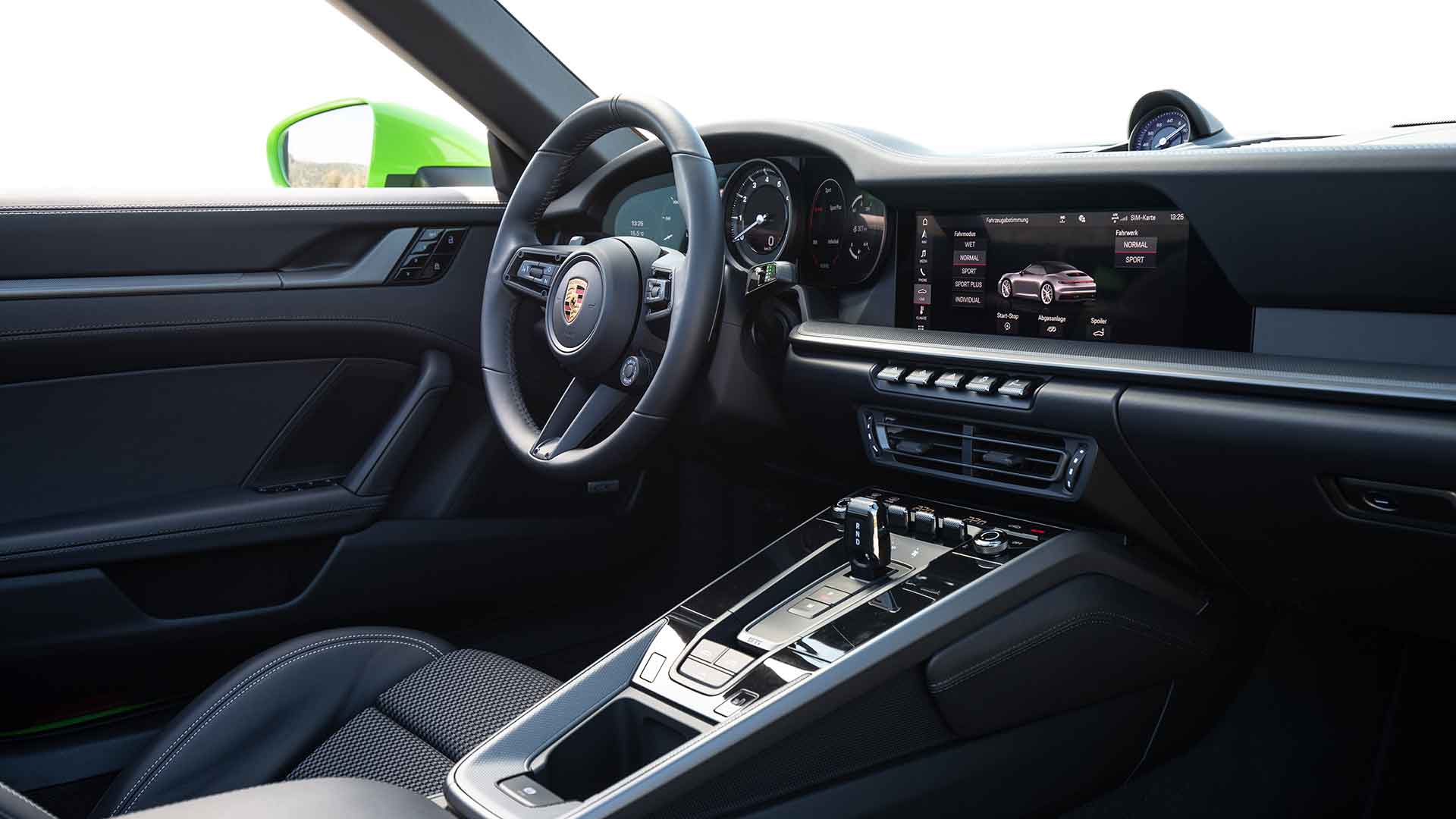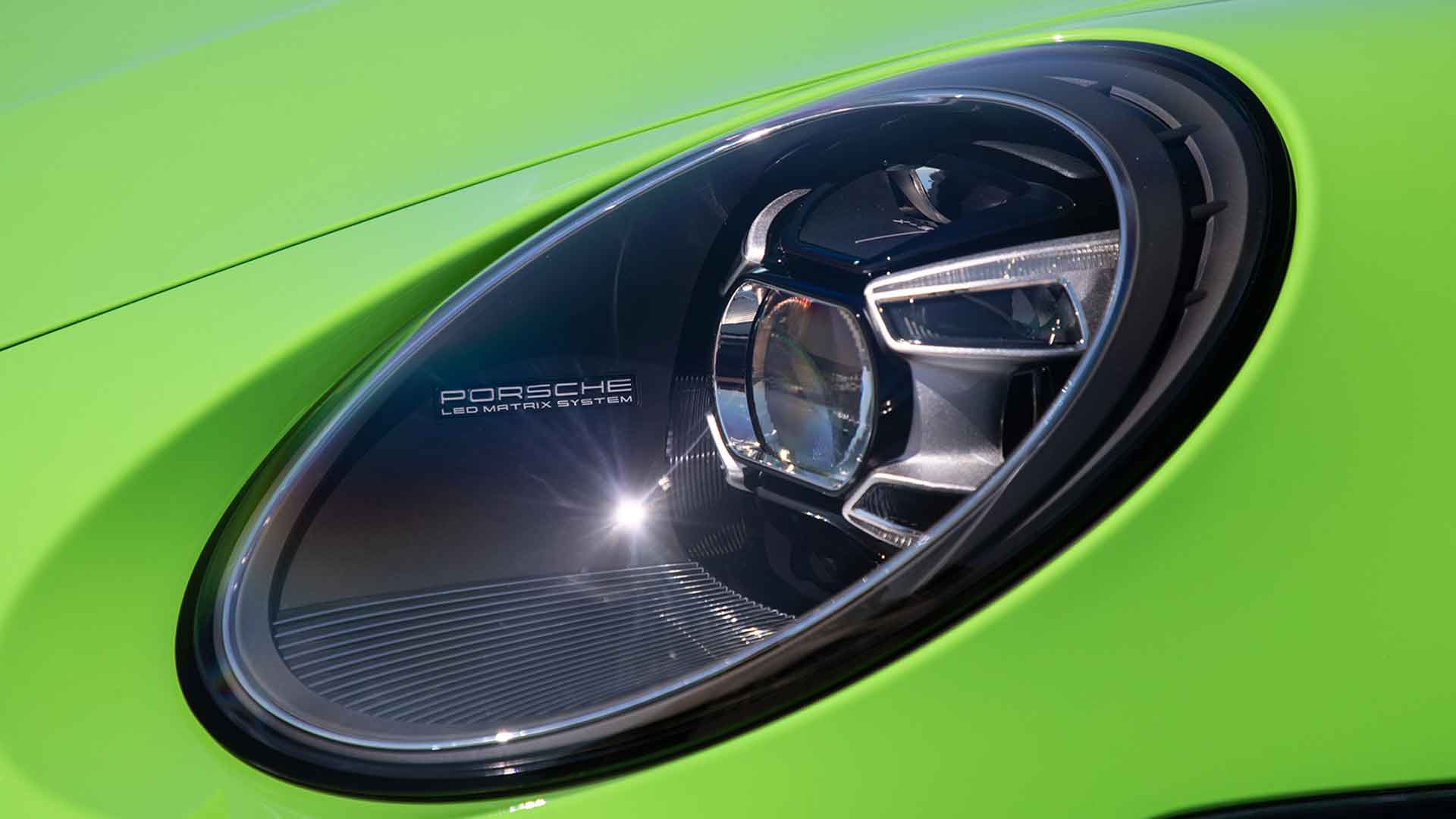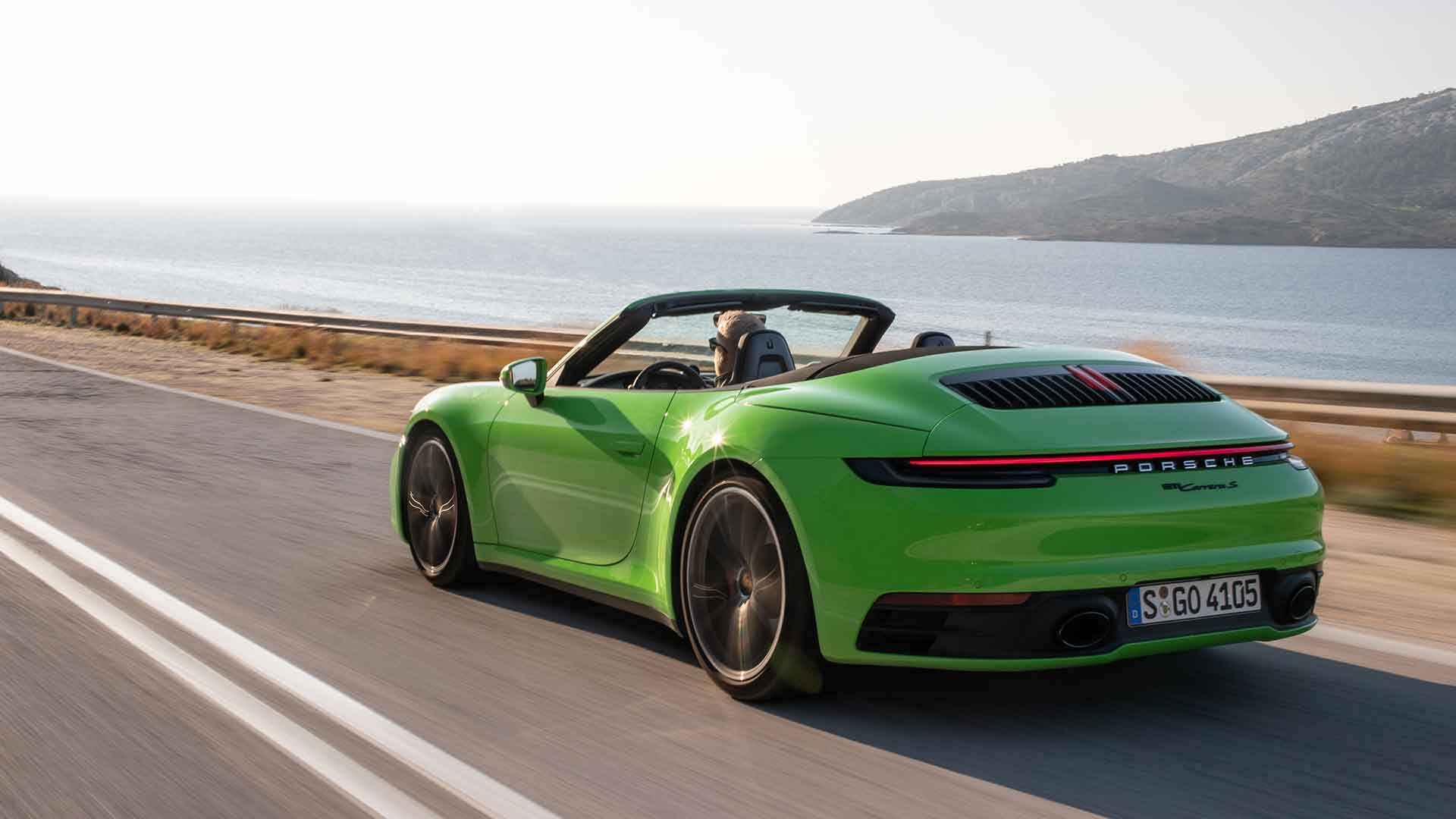
Forget Nordschleife lap-times or willy-waving top speeds. Sports cars are all about sensation: how they look, the noises they make and – above all – how they feel to drive. And nothing heightens those sensations like removing the roof.
Try telling that to Porsche purists, though. They have traditionally seen the 911 Cabriolet as a soft option: a car for boulevards, not B-roads. Granted, the drop-top 911 can’t boast a motorsport pedigree, or indeed a back-catalogue of RS- and GT-badged greatness. But its credentials as a driver’s car have never been in doubt.
So, let’s put snobbery to one side and judge the new Cabriolet simply as a sports car. Here’s hoping it’s, well, sensational.
It starts from nearly six figures

First, the bad news: even the cheapest 911 Cabriolet costs close to six figures. The 385hp Carrera is £92,438, while the four-wheel-drive Carrera 4 will set you back £97,746.
The more powerful 450hp Carrera S (driven here) and 4S start at £102,755 and £108,063 respectively. That’s around £10,000 more than the coupe.
I sampled the paddleshift PDK automatic, but buyers can choose a seven-speed manual. As you’d expect, the list of options is longer than an orangutan’s arm. I’ll come to those shortly.
It does ‘schnell’ very well

The 911 Cabriolet weighs 70kg more than the coupe (1,585kg total), but 450 German Pferdestärke – the same as a 2005 996 Turbo S – means it’s savagely quick. Nigh-on supercar quick.
Zero to 60mph takes 3.7sec in the S – or 3.5sec with the optional Sport Chrono pack, which includes launch control. In both instances, the 4S is 0.1sec swifter. Find an empty Autobahn and you’ll hit 190mph.
This latest 3.0-litre flat-six also serves up a monstrous slab of turbocharged torque: 391lb ft from 2,300rpm. Full power isn’t achieved until 6,500rpm, though, at which point you still have another 1,000 frenzied revolutions left.
Not a case of copy and paste

Designing a new 911 is, one might assume, the easiest job in the world. A straightforward case of copy and paste. However, it’s also something of a poisoned chalice. Get it wrong and the faithful will never forgive you.
To the untrained eye, the 992 does look near-as-dammit identical to its predecessor. In fact, just 15 percent of parts are carried over and the bodyshell is all-new: now 70 percent aluminium, versus 31 percent in the 991.
Dodging downpours in the Porsche 992 Cabriolet.
We’ve started out in the RWD Carrera S, with PDK, Sport Chrono, the -10mm sport chassis and rear-wheel steering. pic.twitter.com/Jc9fL63MJf
— Tim Pitt (@timpitt100) March 13, 2019
The most obvious difference is the full-width rear light bar. Once the preserve of the Carrera 4, it’s now applied across the entire Porsche range. All 911s now have fulsome, Turbo-style hips, too – there’s no longer a ‘narrow body’ option. They’re needed to accommodate larger alloys, now 20 inches at the front and 21 inches at the rear.
One pleasing nod to the past is the bonnet recess in front of the windscreen. It was inspired by the original A- to G-series 911s, built from 1963 to 1989.
It’s a bit of a looker (even with the roof up)

Unlike some 911 Cabriolets of yore, this one also looks good with the roof up. Its hood retains the iconic teardrop shape of the coupe, arcing smoothly into the 992’s bulbous backside.
Electrically lowering or raising the roof takes 12 seconds, at speeds up to 32mph. Once retracted, it lies hidden beneath the rear deck. And going al fresco doesn’t impact on luggage space because, well, the boot is in the front.
Rather than being strictly a ‘soft-top’, the Cabriolet roof consists of four magnesium panels covered in cloth. These allow for that sleeker profile, reduce interior noice and make the hood effectively slash-proof.
The cabin doesn’t let the side down

Ergonomics have never been a 911 forte. The outgoing 991, with its bewildering array of buttons, lagged at least a generation behind the rival Audi R8.
Thankfully, the 992’s cabin is a genuine step-on. Sure, there are a few age-old 911 quirks – such as the five-dial binnacle, with its outer gauges obscured by the steering wheel – but the 12.3-inch touchscreen media system (shared with the Cayenne and Panamera) is intuitive to use and looks gorgeous. One notable black mark: there’s Apple Carplay connectivity, but no Android Auto.
Quality has taken a leap, as the latest 911 treads the blurred boundary between cosseting GT and serious sports car. I particularly like the knurled toggle switches on the centre console, which offer swift access to the drive modes and chassis settings.
Lest we forget, the 911 Cabriolet also has rear seats. The backrests are bolt-upright and it feels horribly claustrophobic with the roof up, but they’re still a useful advantage over many competitors.
It’s a 911 turbo that sounds like a 911 Turbo

Among the many things to rile 911 superfans over the years (“You changed WHAT?”), the switch from naturally-aspirated to turbocharged Carreras was a notable line in the sand. Throttle response will never be as electric, they fretted, and the engine won’t sound the same.
Fire up the 992, though, and the rumble from behind your back is unmistakeably a flat-six. The difference here – particularly when you select Sport mode – is that Porsche is no longer being coy about forced induction. The new 911 whooshes and whoops, its wastegate chattering like a WRC car. It sounds overtly and gloriously turbocharged.
At higher revs, that noise swells to a full-bodied roar, the tailpipes snarling and spitting in unbridled fury. And it’s all amplified by having the roof down.
It’s good at playing Gran Turismo

My drive starts on the outskirts of Athens, on roads peppered with potholes and forlorn 1980s hatchbacks. Time to ease myself in gently and test the 911’s grand touring credentials.
Its driving position is infinitely adjustable and very comfortable. The view ahead is framed by those voluptuous front wings and the curvaceous flanks fill the door mirrors. I select Normal mode and leave the gearbox, now with eight speeds, in automatic mode. So far, so good.
My first time driving a 992.
Love how unapologetically turbocharged it sounds. Porsche has really dialled up the whoosh and wastegate flutter.
And it’s all the more noticeable with the roof down, of course. pic.twitter.com/DlpQTVxuvH
— Tim Pitt (@timpitt100) March 13, 2019
On the move, the 911 feels supple without being floaty or imprecise. The PDK shifts seamlessly and the engine remains muted. If you’ve just eased yourself out of a Mercedes-Benz SL or BMW 8 Series, you’ll feel right at home.
With the roof down, the cabin stays impressively calm, particularly if you deploy the pop-up wind deflector. You can chat to passengers at motorway speeds without straining your voice.
But scratch the surface and it’s still a 911

Still, I didn’t come to Greece to pose topless (ahem). So I head inland for the mountains beyond Athens, and the sort of roads that resemble a hand-drawn scribble on the nav screen.
My Carrera S has Sport Chrono, so there’s a manettino-style dial on the wheel for engaging Sport and Sport Plus modes. I start off in the former and switch to manual mode, sensing the 911 stiffen and tense its fibres for action. The whole car suddenly feels emancipated.
New Porsche 992 interior.
The five-dial binnacle is classic 911 – and the steering wheel still obscures the outer gauges.
The optional Burmester hi-fi, which weighs just 6kg, is sensationally good. Even when pre-loaded with Dire Straits albums by our German hosts… pic.twitter.com/42agKZoAdK
— Tim Pitt (@timpitt100) March 13, 2019
On steeply climbing switchbacks, the combination of an engine beyond the back axle and steamroller 305-section rear rubber means incredible traction. The 911 hunkers down, then slingshots out of bends like a scalded cheetah. It makes you question the need for the four-wheel-drive 4S.
All that grip is complemented by an almighty wallop of torque, catapulting the car between bends with sustained, elastic speed. Those on-paper numbers don’t deceive: the 911 is awesomely and addictively rapid.
A car with Sports Purpose

Nonetheless, a 911 isn’t defined by its point-to-point pace. How it goes around corners is what matters most.
You can breathe easy. The 911’s electric steering (another former bugbear of the fanboys) has evolved to the point where it feels as alert and engaging as most hydraulic systems – while adeptly filtering out white noise.
Equally, the 992 is a car you steer with the throttle, trimming its line with minute flexes of your right ankle. You feel the car pivot, sensing the available grip through the seat of your pants. It’s approachable and benign, yet aggressive and all-consuming. Having blasted to the summit, I turn around and do it again.
Our car had the optional PDCC chassis control, which all but elimates roll by actively stiffening the suspension. Even with it disengaged, however, body control feels iron-fisted. Any concerns about the 911 Cabriolet being a soft option have evaporated.
Half-way through my second ‘lap’ of the mountain, it starts to rain and the acoustic sensors in the front wheelarches suggest I switch to Wet mode. This ramps up the stability control and calms the car’s responses. I cruise back to Athens with wipers on and the roof firmly in place.
The joy of specs

Like any upmarket German car, you can ‘personalise’ your 911 to the point of financial meltdown. The good news, as ever, is that most of it is window dressing. The basic package – including LED headlights, front and rear parking sensors, adaptive suspension and navigation – is all you really need.
Since I’m spending made-up money, I’d go for Sport Chrono (£1,646) and the gorgeous RS Spyder Design wheels seen here (£1,650). I’d also be tempted by the Sport Design Pack (£2,853), which improves the rear-end styling by relocating the number plate higher up. Oh, and perhaps by one of the eye-poppingly bright paint colours, such as Lizard Green (pictured).
My test car was fitted with rear-wheel steering (£1,592), boosting agilty at low speeds and stability as you go faster. However, without trying a 911 not thus-equipped, I can’t fully comment on its effectiveness.
Porsche 911 Cabriolet verdict: five stars

The 911 Cabriolet is indeed a feast for the senses. Its brutally quick and deliciously tactile to drive. Against the odds, it’s aurally awesome too.
What impresses most is the 992’s sheer breadth of ability. How it switches from calm to combative without pausing for breath. And how it’s still relatively practical for a sports car. As a daily driver, it would surely tick most boxes.
If I’m honest, I’d still err towards the coupe. But that’s more due to irrational prejudice than any discernable shortfall on the Cabriolet’s part. Perhaps I’ll just save up and wait a year or two for the Targa.
Porsche 911 Carrera S Cabriolet: specification
Price: £102,755
Engine: Flat-six cylinder twin-turbo 2,981cc petrol
Drivetrain: Rear-engine, rear-wheel drive
Transmission: Eight-speed dual-clutch automatic
Wheels: 20 inches front, 21 inches rear
Power: 450hp@6,500 rpm
Torque: 391lb ft@2,300rpm
0-60mph: 3.7sec (3.5sec with Sport Chrono)
Top speed: 190mph
Fuel economy: 31mpg
CO2 emissions: 208g/km
Length/width/height: 4,519/1,852/1,299mm
Kerb weight: 1,585kg
ALSO READ
Footballer’s one-off GOLD Aston Martin DB7 for sale
New Porsche endurance racing documentary now available to watch